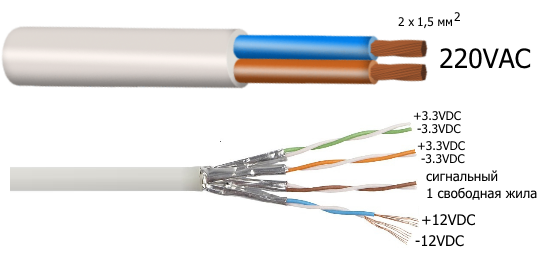Answer the question
In order to leave comments, you need to log in
Is twisted pair suitable for 12V and 3.3V signals?
While the repair is underway, it is necessary to lay additional wiring in the wall for the implementation of the "Smart Home" in the future.
More precisely, it is necessary to lay the following wires in each switch (11 pcs):

Answer the question
In order to leave comments, you need to log in
1. Will endure. The power supply to the video cameras is approximately the same, only "constant" current is provided.
2. It will come, but then it depends on what signal.
Ideally, you should use an STP cable and ground the braid. It is also desirable to separate the weak current from the power one by at least 50 cm. Even better is additional shielding when laying end-to-end - such as a metal hose. It is even better to use a monocore, and those multicore as in the photo can rot faster.
The only few lived in reserve - you need at least 10 -
KSREVng (A) -FRLS 10x0.5 (0.2 sq mm) or 380-0056-10014 - shielded 10-core control cable of the CONTROL FLEX series (AWG 25)
For wires, a current density of the order of 3A per mm ^ 2 is allowed (most likely more). I don’t know what cross section the vitukha has, but it seems to be enough. The relay typically draws about 100mA. Are you sure about 0.5A+?
I won't say anything about interference. If there is a ready-made device, maybe it's worth wrapping these 18m around the refrigerator and see if the sensor will work? And then shove it into the wall :)
IMHO, somehow you overdid it. I don’t see any reason to have so many wires, several power supplies, something separately for an LED, etc. Can you reconsider the concept? As an option, for example here:
https://geektimes.ru/post/259336/
I also plan to do something similar, but I see it differently. Yes, a twisted pair will also fall, but it will be like this:
1. 2 cores - power supply 5 or 12V, each device will have its own pulse converter.
2. 2 wires - RS485
3. 2 wires - TTL RS232 Rx + Tx (possible)
4. 2 wires - reserve, for future use.
I don’t see the point in pulling 220V at all, all the same, LED lamps will be installed everywhere and each will have a low-voltage controlled IP. Because in each node of the home grid (I plan to ModBus) there will still be MK, then pulling discrete signals, I also don’t see the point. This is how I see it, maybe something will change, but not radically. It may be a 4- or 6-wire telephone-type cable, with a network connection via RJ22.
IMHO I do not advise you to run 220v over twisted pair. The rules for the installation of electrical equipment prescribe to separate low-current and power lines. and the rest: it should take off.
(From practice - The power supply of CCTV cameras is usually 0.6 ... 0.8 A, 12V. When using 1 pair, drawdowns often occur.) So it's better to use 2 pairs.
Didn't find what you were looking for?
Ask your questionAsk a Question
731 491 924 answers to any question